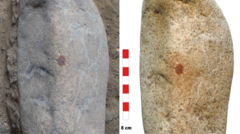Scientists in Spain have made a groundbreaking discovery, revealing the oldest known complete human fingerprint linked to a Neanderthal, which may suggest that these ancient humans were capable of creating art. The finding centers around a pebble that appears to have a red dot resembling a nose, believed to have been painted by a Neanderthal man approximately 43,000 years ago. This pebble was found in the San Lázaro rock shelter in Segovia, Spain, leading researchers to rethink Neanderthals' abilities for abstract thought and symbolic behaviors.
The discovery was made by a team that began excavation at the site five years ago. Co-author María de Andrés-Herrero from the University of Complutense in Madrid described their amazement upon uncovering the stone, which stood out among other artifacts due to its size and the distinct red dot that depicted a face. Initially, the team questioned whether the mark was made using ochre, a naturally occurring pigment, but thorough analysis confirmed its composition.
Researchers collaborated with Spain's scientific police to employ advanced multi-spectrum analysis, which unveiled the human fingerprint as belonging to an adult male. However, co-author David Álvarez Alonso emphasized the difficulty in definitively connecting the fingerprint to a specific Neanderthal due to a lack of comparative references.
The pebble has been recognized as the earliest known portable artwork from Europe and the only painted object confirmed to have been created by Neanderthals. Prof de Andrés-Herrero highlighted the significance of this finding in illuminating Neanderthals' symbolic capabilities, as it represents the first instance of a pigment-marked object discovered in an archaeological context.
Moreover, the fingerprint's context—non-utilitarian—indicates the mark’s intention for artistic expression. Researchers believe the Neanderthal was drawn to the rock's unique features and deliberately applied ochre to it. Furthermore, the absence of red pigment in the shelter suggests it was brought specifically for this creative act. Their findings are documented in the journal Archaeological and Anthropological Sciences, which states that the pebble's characteristics mark it as a potential piece of portable art, illuminating new dimensions of Neanderthal behavior and culture.



















